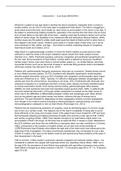Assessment 1 – Case Study (BMS24445)
Whenever a patient at any age starts to develop the above symptoms, especially when it comes to
swollen ankles, we can link it to the early signs of progressive heart failure. The heart is struggling to
pump blood around the body, and it builds up, also known as accumulation in the veins in your legs. If
the patient is experiencing swelling symptoms, especially in the evening time then there may be some
form of heart failure on the right side of the heart – swelling could also be linked to factors such as the
effects of certain drugs, the possibility of an unbalanced diet and kidney/liver failures (Watson, 2000).
Another cause why the patient’s ankles might swell would be linked to Edema which is when there is
fluid trapped in the body’s tissue. Patients could notice it in certain areas of their body, but it can be
more prominent in feet, ankles, and legs – thus linked to another underlying disease of congestive
heart failure (Clark and Cleland, 2013).
Heart failure is a pathophysiologic condition in which the heart's inability to pump blood at a rate
sufficient to meet the needs of the body's metabolic tissues results from faulty cardiac function
(Gardner et al., 2007). Practically speaking, pulmonary congestion and peripheral hypoperfusion are
the two main clinical symptoms of heart failure. Cardiac failure is defined as having an insufficient
cardiac output; hence, even when there is normal cardiac output (i.e., no cardiac failure), abnormal
myocardial function (such as an abnormal increase in ventricular filling pressure and/or end-diastolic
ventricular volume) may still exist (Tan et al., 2010).
Patients with cardiomyopathy frequently experience chest pain as a symptom. Despite having normal
or even dilated coronary arteries, 39-72% of patients with idiopathic hypertrophic cardiomyopathy
describe anginal discomfort, and up to 52% of patients with congestive cardiomyopathy report vague
chest pain (Pasternac et al., 1982). Typically, it is difficult to distinguish between oesophageal and
cardiac pain from the clinical history. According to one study, 25% of individuals with chest pain who
underwent evaluation by a cardiologist had their coronary artery disease incorrectly identified based
on clinical examination results. Even during exercise testing, gastroesophageal reflux disease
(GERD) can elicit exertional chest pain that resembles angina pectoris (Katz, 2000). In patients with
recurrent substernal discomfort, a thorough cardiac assessment is advised as the initial course of
action due to the difficulties in differentiating between cardiac and oesophagus pain. Many factors,
such as the patient's age and other cardiac risk factors, influence the type of workup that is
performed. The gold standard for diagnosing coronary angiography remains coronary angiography,
even though a non-invasive workup including an electrocardiogram, exercise testing, and maybe
echocardiography is adequate to rule out heart illness (Parsonage et al., 2013).
Patients that are experiencing symptoms of coughing, could be developing signs of a chronic cough,
also known as a cardiac cough. This happens due to the heart’s incapability of being able to pump
blood efficiently to the lungs and circulate it back. If the patient hasn’t been treated for CHF and does
find themselves wheezing and feeling shortness of breath, this could be a main sign of CHF, COPD,
and cardiac coughing (Snider, 1989). Fluid retention brought on by heart failure might result in an
accumulation of fluid in the lungs. As the body tries to expel this fluid, it causes a cough. Medications
like ACE inhibitors and those that are ineffective or improperly taken can also contribute to it (Corless,
1982). Linking back to the symptom of swollen ankles, we can also look at the possibility of
COPD/Pulmonary Heart Disease which affects the right side of the heart which was referenced at the
beginning of this investigation. The signs of pulmonary hypertension may not develop for over a few
months or maybe a few years so the patient could be just experiencing these problems at the peak of
their development in the heart.
CHF is common, it often results in pulmonary vascular congestion and reduced cardiac output – it is
considered in patients who appear with dyspnoea and/or any respiratory failure (Slota, 1982). Up to
the age of 65, the prevalence of heart failure rises gradually with age before increasing more quickly.
Heart failure is thought to be rather common in the UK. 1 in 35 persons aged 65 to 74. 1 in 15 persons
aged 75 to 84.




